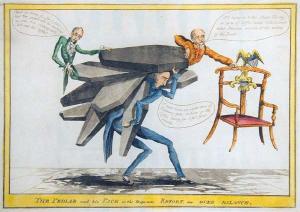On February 21, 1815, six militia men (all of the Tennessee militia) were court-martialed and executed while under General Andrew Jackson’s command. When Jackson ran for President of the United States in 1828, the incident was used against him by those in favor of his opponent, John Quincy Adams.
This satirical print depicts editor-publisher John Binn, who published a number of handbills that accused Jackson of arbitrary executions, as well as other violent acts. The anger campaign somewhat back-fired and led to pro-Jackson handbills and cartoons, such as this one. Binn is seen here supporting a load of coffins on his back, along with the figures of Henry Clay on the left and the incumbent President John Quincy Adams on the right. Binns: “I must have an extra dose of Treasury-pap, or down go the Coffins Harry, for I feel faint already.” Clay: “Hold on Jonny Q—for I find that the people are too much for us, and I’m sinking with Jack and his Coffins!” Adams: “I’ll hang on to the Chair Harry, in spite of Coffin hand-bills Harris’s letter Panama mission or the wishes of the People.”
This led to a full-blown mud-slinging campaign on both sides. Adams was accused of misusing public funds (he bought a chessboard and a pool table). In addition to the murders, Jackson was accused of adultery (his wife’s divorce papers were not finalized before their marriage). In the end, Jackson’s popularity grew and he won the election. The final electoral vote results were: Jackson 178, Adams 83.
